#Google reviews are customer reviews of businesses that are posted on Google. Google reviews are a great way for customers to provide feedba
Text
sometimes you talk to a person at a 1.5-star pharmacy and immediately realize exactly why it has that rating.
#my mans repeatedly shouted that i was wasting his time when there are real customers who need medication#and that instead of using his store's drive thru i should walk into my current pharmacy while covid positive.#ok sir! i'll do that right away!#i usually only use google reviews to leave positive reviews of local businesses but this guy.... ooooooough god i am tempted.#autoimmune tag#covid posting#what a piece of fucking shit. shouted back at him til i got what i needed tho so all is well
15 notes
·
View notes
Text

#👉Buy Negative Google Reviews#Online reviews have become an increasingly important factor in the success of businesses. Particularly those operating on digital platforms#some people and businesses take advantage of these tactics to defame their competition by buying negative reviews. Buying negative reviews#we will discuss the implications of buying negative Google review. And the potential effects it can have on your business. We will explore#When it comes to digital marketing and online presence. There is no denying the importance of Google reviews. After all#Google reviews are one of the most important signals used to assess the quality of a business. Not surprisingly#businesses are eager to get as many positive reviews as possible. But#there is an often overlooked feature involved in Google reviews. The ability to buy negative reviews. Yes#it sounds strange but it is a legitimate practice that many businesses are using to their advantage.#Buying negative Google reviews may seem counterintuitive. But it can be a great way to boost your online presence. It’s not only a way to e#you can make sure that your business stands out from the competition and presents itself in the best possible light.#👉What is Negative Google review?#Negative Google reviews are a bane of businesses in the modern digital age. As more customers use the internet to rate businesses. It is be#and must to understand what a negative review looks like and how to deal with them. The goal of this blog post is to explain what a negativ#Google reviews are customer reviews of businesses that are posted on Google. Google reviews are a great way for customers to provide feedba#not all reviews are positive. Negative reviews can be damaging to a business’s reputation and can significantly harm their online presence.#Negative reviews can have an immense impact on businesses and their reputations#especially. When they are posted on trusted and widely-used websites such as Google. Google reviews are often one of the first resources th#And how to handle them#can help business owners protect their online reputation and foster long-term customer loyalty. In this blog post#we will discuss what a negative Google review is. Why they can be damaging#and how businesses can respond to them appropriately. We will also provide some tips and best practices for dealing with negative reviews.
1 note
·
View note
Text
With the various rumors and releases of Tumblr possibly changing how they do things... (gestures to the vague rumor mill)...

Zines.
I really think we as Folks Who Make Things and Folks Who Like Art Writing Poetry Music Comics Other Things need to explore zines. And I mean ZINES. Nothing glossy. Nothing fancy.
Very.
Cheap.
Zines.
I've been threatening mentioning I was going to create a guide on how I'm going to approach this -- and I'm going to -- but I am also realizing in the writing I Do Things Highfalutin because I am who I am + had a career in graphic design.

Let's talk about how you can make a zine very cheaply and very pretty.
STEP ONE: SUPPLIES
Very bright paper. I like "Astrobrights" because they are absurdly bright. Here is a link in a store I like. I buy a lot of paper and envelopes from them. You can generally find Astrobrights in big box office stores. It prints on laser printers and ink jet and photocopiers.
Very bright envelopes. What's that? Astrobrights has envelopes?! AM I SOLVING PROBLEMS let's not get ahead of ourselves.
Letter paper is 8.5" x 11" and is the most common size in the united states (overseas folk will have to use this advice with a grain o'sea salt and search yer own waters).
A9 envelopes are a letter sheet folded in half.
A2 envelopes are a letter sheet folded in half, then folded in half.
#10 envelopes are your common long envelopes, letter paper folded in thirds.
Pick the size you like.
If you want to get big and fancy, Tabloid is 17" x 11" -- so double a letter sheet. This gets tricky to work with but is neat in sizing.
STEP TWO: ZINE CONTENT
Do you know how to use InDesign or similar program? Use that.
No? Use Google Docs or Word or whatever other program and ramble.
Want something special? Write out some or part with a sharpee or pen.
Mix and match both.
If you are feeling fancy, design it like a booklet -- mock up a sheet of blank paper as if it were a brochure. If not, just design it straight up and down like a letter. There are no zine laws.

STEP THREE: ZINE PRINTING
Print at home on your home printer.
Don't have a printer at home? Print it at work (don't get fired)
Can't? Your local library may be able to help.
You need 1 copy on white paper.
FedEx Office has photocopiers. Your local library may too. Or your job.
Print 1 copy of your zine on white paper and then photocopy the rest onto colorful paper (or white paper, it be yer zine seadog).
Or print everything on the color paper if you have access to free printing, that's fine too.
The photocopy setup is purely "printing tends to cost more than photocopying."
If you want to slash prices, print 2 per sheet and have FedEx office cut them for you, this will cost $1 - $5 depending on how many sheets you are dealing with. This is for when you're doing a LOT of zines at once.
Or use their manual paper cutter yourself for free.
STEP FOUR: ZINE STAPLING
"Long reach stapler" is what I recommend. There are a few varieties. They tend to be $20 - $30.
Or just use 1 sheet!

STEP FOUR: ZINE POSTAGE
A single first class stamp for 1-2 pages. If you get up to 3+, go to the post office and ask them to weigh a comp you have assembled.
This is a guideline.
It's a really good idea to check at least once how much your zine weighs just in general. Post offices have scales. And are pretty. And have stamps.
OKAY ENOUGH LUSTING FOR THE POST OFFICE FROM THE GHOTS POST OFFICE BLOG BACK TO WORK
STEP FIVE: ZINE MAILING
This is actually the most difficult part. Label printers exist with various costs -- if you're starting out? Go with printable labels.
Your office supply shop will have them and they'll have templates you can drop in the customer addresses.
Save yourself time by using this label as the thing that seals the envelope -- don't lick envelopes.
A key tenet to staying in business is constantly reviewing physical (and mental) labor and stressors and reducing them as much as possible.
Return address labels are intensely cheap in literally every online printer, google "return address labels." Make sure you have this because at least a few of your shipments will come back to you.

STEP SIX: ZINE PRICING
Okay here is where we get uncomfortable because we're talkin' coins.
Prices are based on above links. You can get whatever paper you want, so this is guidelines. All numbers rounded up.
Payment processing ($0.30) + $0.05 sheet + $0.15 envelope + $0.66 first class postage = $1.16 base cost
$1.16 + 2.9% of $1.16 payment processing = $1.20
Plus taxes. I'm not getting into tax figures YOU DO THAT (just say 30% for easy math, this is not saying "your taxes are 30% or that mine are" I am saying "I am going to factor 30% for this equation to complete this guide".)
I did not include the mailing label (it will be $0.01 - $0.05 depending on how fancy and how many you buy) because you have the option to just write things and also it fits into the rounding of the above.
If you use Patreon, include your fees. Probably replace the above processing fees with your patreon processing... fees? I don't use patreon I don't know how it works.
Retail option 01:
$1.50 - 1.20 = $0.80 gross - 30% = $0.09 / net / zine.
Retail option 02:
$2 - 1.20 = $0.80 gross - 30% = $0.56 / net / zine.
Retail option 03:
$3 - 1.20 = $1.80 gross - 30% = $1.26 / net / zine.
Should it be $1.50?
Should it be $3.00? MORE? LESS?!
That is for you to decide. Base it on what your zine contains, how long it takes you to write/draw/etc. it and how you want your flow to be.

STEP SEVEN: ZINE FREQUENCY
When my shop launches, it'll have a zine once a month. We are going to offer a subscription option + a "I just want 1" option.
You can do a zine monthly, or every few months, or whatever.
Keep in mind that the purpose of doing this is to break the dependency on social media marketing.
KEEP IN MIND AS AN AUDIENCE MEMBER TO A CREATOR YOU LIKE THAT THEY ARE DOING THIS TO BREAK THEIR DEPENDENCY ON SOCIAL MEDIA MARKETING.
If you have a lot of energy and an audience that comes to your shop a lot? Consider doing a zine monthly.
If you do not have a lot of energy and/or your audience is tapped for cash frequently? Considering doing 1 zine per season.
Consider 2 zines a year if that works better for you!
NO RULES ONLY JOY
Not sure? Experiment! Be upfront! "This is new. I'm figuring this out. Billionaires are tinkering with these things and we gotta figure something else out."
BONUS STEP: NETHERWORLDPOST.COM
so hi I'm atty and I'm your loud long rambler today
Netherworld Post Office used to be @evilsupplyco and now we are rebranding in prep of relaunching. Same person behind the rambles and comics, new name with a more focus (mail instead of mail + seemingly everything else in experiment)
if you enjoyed this ramble and/or like ghosts, monsters, witches, mermaids, and fun stories and projects focused on cozy Halloween, you may like us when we finish the rebranding and relaunching in autumn 2023.
email sign up (the zine will come when we are open)

WHETHER YOU JOIN MY LIST OR NOT
I really, really, really hope you consider doing a regular, or irregular, zine. Something outside of email, something outside of social media, something that connects I MADE A WEIRD THING and the people who say I LOVE THIS WEIRD THING YOU MADE.
The walls are closing in on free social media as a platform for people who make weird things to build audiences for free or very cheap.
And with that...
netherworldpost.com as one final hat pass
good luck folks
thanks for listenin' to the ol' ghost
1K notes
·
View notes
Text
Big Tech disrupted disruption

If you'd like an essay-formatted version of this post to read or share, here's a link to it on pluralistic.net, my surveillance-free, ad-free, tracker-free blog:
https://pluralistic.net/2024/02/08/permanent-overlords/#republicans-want-to-defund-the-police

Before "disruption" turned into a punchline, it was a genuinely exciting idea. Using technology, we could connect people to one another and allow them to collaborate, share, and cooperate to make great things happen.
It's easy (and valid) to dismiss the "disruption" of Uber, which "disrupted" taxis and transit by losing $31b worth of Saudi royal money in a bid to collapse the world's rival transportation system, while quietly promising its investors that it would someday have pricing power as a monopoly, and would attain profit through price-gouging and wage-theft.
Uber's disruption story was wreathed in bullshit: lies about the "independence" of its drivers, about the imminence of self-driving taxis, about the impact that replacing buses and subways with millions of circling, empty cars would have on traffic congestion. There were and are plenty of problems with traditional taxis and transit, but Uber magnified these problems, under cover of "disrupting" them away.
But there are other feats of high-tech disruption that were and are genuinely transformative – Wikipedia, GNU/Linux, RSS, and more. These disruptive technologies altered the balance of power between powerful institutions and the businesses, communities and individuals they dominated, in ways that have proven both beneficial and durable.
When we speak of commercial disruption today, we usually mean a tech company disrupting a non-tech company. Tinder disrupts singles bars. Netflix disrupts Blockbuster. Airbnb disrupts Marriott.
But the history of "disruption" features far more examples of tech companies disrupting other tech companies: DEC disrupts IBM. Netscape disrupts Microsoft. Google disrupts Yahoo. Nokia disrupts Kodak, sure – but then Apple disrupts Nokia. It's only natural that the businesses most vulnerable to digital disruption are other digital businesses.
And yet…disruption is nowhere to be seen when it comes to the tech sector itself. Five giant companies have been running the show for more than a decade. A couple of these companies (Apple, Microsoft) are Gen-Xers, having been born in the 70s, then there's a couple of Millennials (Amazon, Google), and that one Gen-Z kid (Facebook). Big Tech shows no sign of being disrupted, despite the continuous enshittification of their core products and services. How can this be? Has Big Tech disrupted disruption itself?
That's the contention of "Coopting Disruption," a new paper from two law profs: Mark Lemley (Stanford) and Matthew Wansley (Yeshiva U):
https://papers.ssrn.com/sol3/papers.cfm?abstract_id=4713845
The paper opens with a review of the literature on disruption. Big companies have some major advantages: they've got people and infrastructure they can leverage to bring new products to market more cheaply than startups. They've got existing relationships with suppliers, distributors and customers. People trust them.
Diversified, monopolistic companies are also able to capture "involuntary spillovers": when Google spends money on AI for image recognition, it can improve Google Photos, YouTube, Android, Search, Maps and many other products. A startup with just one product can't capitalize on these spillovers in the same way, so it doesn't have the same incentives to spend big on R&D.
Finally, big companies have access to cheap money. They get better credit terms from lenders, they can float bonds, they can tap the public markets, or just spend their own profits on R&D. They can also afford to take a long view, because they're not tied to VCs whose funds turn over every 5-10 years. Big companies get cheap money, play a long game, pay less to innovate and get more out of innovation.
But those advantages are swamped by the disadvantages of incumbency, all the various curses of bigness. Take Arrow's "replacement effect": new companies that compete with incumbents drive down the incumbents' prices and tempt their customers away. But an incumbent that buys a disruptive new company can just shut it down, and whittle down its ideas to "sustaining innovation" (small improvements to existing products), killing "disruptive innovation" (major changes that make the existing products obsolete).
Arrow's Replacement Effect also comes into play before a new product even exists. An incumbent that allows a rival to do R&D that would eventually disrupt its product is at risk; but if the incumbent buys this pre-product, R&D-heavy startup, it can turn the research to sustaining innovation and defund any disruptive innovation.
Arrow asks us to look at the innovation question from the point of view of the company as a whole. Clayton Christensen's "Innovator's Dilemma" looks at the motivations of individual decision-makers in large, successful companies. These individuals don't want to disrupt their own business, because that will render some part of their own company obsolete (perhaps their own division!). They also don't want to radically change their customers' businesses, because those customers would also face negative effects from disruption.
A startup, by contrast, has no existing successful divisions and no giant customers to safeguard. They have nothing to lose and everything to gain from disruption. Where a large company has no way for individual employees to initiate major changes in corporate strategy, a startup has fewer hops between employees and management. What's more, a startup that rewards an employee's good idea with a stock-grant ties that employee's future finances to the outcome of that idea – while a giant corporation's stock bonuses are only incidentally tied to the ideas of any individual worker.
Big companies are where good ideas go to die. If a big company passes on its employees' cool, disruptive ideas, that's the end of the story for that idea. But even if 100 VCs pass on a startup's cool idea and only one VC funds it, the startup still gets to pursue that idea. In startup land, a good idea gets lots of chances – in a big company, it only gets one.
Given how innately disruptable tech companies are, given how hard it is for big companies to innovate, and given how little innovation we've gotten from Big Tech, how is it that the tech giants haven't been disrupted?
The authors propose a four-step program for the would-be Tech Baron hoping to defend their turf from disruption.
First, gather information about startups that might develop disruptive technologies and steer them away from competing with you, by investing in them or partnering with them.
Second, cut off any would-be competitor's supply of resources they need to develop a disruptive product that challenges your own.
Third, convince the government to pass regulations that big, established companies can comply with but that are business-killing challenges for small competitors.
Finally, buy up any company that resists your steering, succeeds despite your resource war, and escapes the compliance moats of regulation that favors incumbents.
Then: kill those companies.
The authors proceed to show that all four tactics are in play today. Big Tech companies operate their own VC funds, which means they get a look at every promising company in the field, even if they don't want to invest in them. Big Tech companies are also awash in money and their "rival" VCs know it, and so financial VCs and Big Tech collude to fund potential disruptors and then sell them to Big Tech companies as "aqui-hires" that see the disruption neutralized.
On resources, the authors focus on data, and how companies like Facebook have explicit policies of only permitting companies they don't see as potential disruptors to access Facebook data. They reproduce internal Facebook strategy memos that divide potential platform users into "existing competitors, possible future competitors, [or] developers that we have alignment with on business models." These categories allow Facebook to decide which companies are capable of developing disruptive products and which ones aren't. For example, Amazon – which doesn't compete with Facebook – is allowed to access FB data to target shoppers. But Messageme, a startup, was cut off from Facebook as soon as management perceived them as a future rival. Ironically – but unsurprisingly – Facebook spins these policies as pro-privacy, not anti-competitive.
These data policies cast a long shadow. They don't just block existing companies from accessing the data they need to pursue disruptive offerings – they also "send a message" to would-be founders and investors, letting them know that if they try to disrupt a tech giant, they will have their market oxygen cut off before they can draw breath. The only way to build a product that challenges Facebook is as Facebook's partner, under Facebook's direction, with Facebook's veto.
Next, regulation. Starting in 2019, Facebook started publishing full-page newspaper ads calling for regulation. Someone ghost-wrote a Washington Post op-ed under Zuckerberg's byline, arguing the case for more tech regulation. Google, Apple, OpenAI other tech giants have all (selectively) lobbied in favor of many regulations. These rules covered a lot of ground, but they all share a characteristic: complying with them requires huge amounts of money – money that giant tech companies can spare, but potential disruptors lack.
Finally, there's predatory acquisitions. Mark Zuckerberg, working without the benefit of a ghost writer (or in-house counsel to review his statements for actionable intent) has repeatedly confessed to buying companies like Instagram to ensure that they never grow to be competitors. As he told one colleague, "I remember your internal post about how Instagram was our threat and not Google+. You were basically right. The thing about startups though is you can often acquire them.”
All the tech giants are acquisition factories. Every successful Google product, almost without exception, is a product they bought from someone else. By contrast, Google's own internal products typically crash and burn, from G+ to Reader to Google Videos. Apple, meanwhile, buys 90 companies per year – Tim Apple brings home a new company for his shareholders more often than you bring home a bag of groceries for your family. All the Big Tech companies' AI offerings are acquisitions, and Apple has bought more AI companies than any of them.
Big Tech claims to be innovating, but it's really just operationalizing. Any company that threatens to disrupt a tech giant is bought, its products stripped of any really innovative features, and the residue is added to existing products as a "sustaining innovation" – a dot-release feature that has all the innovative disruption of rounding the corners on a new mobile phone.
The authors present three case-studies of tech companies using this four-point strategy to forestall disruption in AI, VR and self-driving cars. I'm not excited about any of these three categories, but it's clear that the tech giants are worried about them, and the authors make a devastating case for these disruptions being disrupted by Big Tech.
What do to about it? If we like (some) disruption, and if Big Tech is enshittifying at speed without facing dethroning-by-disruption, how do we get the dynamism and innovation that gave us the best of tech?
The authors make four suggestions.
First, revive the authorities under existing antitrust law to ban executives from Big Tech companies from serving on the boards of startups. More broadly, kill interlocking boards altogether. Remember, these powers already exist in the lawbooks, so accomplishing this goal means a change in enforcement priorities, not a new act of Congress or rulemaking. What's more, interlocking boards between competing companies are illegal per se, meaning there's no expensive, difficult fact-finding needed to demonstrate that two companies are breaking the law by sharing directors.
Next: create a nondiscrimination policy that requires the largest tech companies that share data with some unaffiliated companies to offer data on the same terms to other companies, except when they are direct competitors. They argue that this rule will keep tech giants from choking off disruptive technologies that make them obsolete (rather than competing with them).
On the subject of regulation and compliance moats, they have less concrete advice. They counsel lawmakers to greet tech giants' demands to be regulated with suspicion, to proceed with caution when they do regulate, and to shape regulation so that it doesn't limit market entry, by keeping in mind the disproportionate burdens regulations put on established giants and small new companies. This is all good advice, but it's more a set of principles than any kind of specific practice, test or procedure.
Finally, they call for increased scrutiny of mergers, including mergers between very large companies and small startups. They argue that existing law (Sec 2 of the Sherman Act and Sec 7 of the Clayton Act) both empower enforcers to block these acquisitions. They admit that the case-law on this is poor, but that just means that enforcers need to start making new case-law.
I like all of these suggestions! We're certainly enjoying a more activist set of regulators, who are more interested in Big Tech, than we've seen in generations.
But they are grossly under-resourced even without giving them additional duties. As Matt Stoller points out, "the DOJ's Antitrust Division has fewer people enforcing anti-monopoly laws in a $24 trillion economy than the Smithsonian Museum has security guards."
https://www.thebignewsletter.com/p/congressional-republicans-to-defund
What's more, Republicans are trying to slash their budgets even further. The American conservative movement has finally located a police force they're eager to defund: the corporate police who defend us all from predatory monopolies.

Image:
Cryteria (modified)
https://commons.wikimedia.org/wiki/File:HAL9000.svg
CC BY 3.0
https://creativecommons.org/licenses/by/3.0/deed.en
#pluralistic#coopting disruption#law and political economy#law#economics#competition#big tech#tech#innovation#acquihires#predatory acquisitions#mergers and acquisitions#disruption#schumpeter#the curse of bigness#clay christensen#josef schumpeter#christensen#enshittiification#business#regulation#scholarship
285 notes
·
View notes
Text
Business Guide:
How to get started
When you have a business name in mind look up the domain name to see if it’s taken. You don’t want to spend money on an LLC just to find out that your name is taken. Thats a waste of money because you also have to pay to dissolve it.
If the name is not taken, great, don’t file an LLC yet. Go online and get a virtual business address. Why? If you’re running your business out of your home like I am, just know that it’s public information if you use your address to file your LLC. A virtual address should cost like $10-$20 a month. Use that to file your LLC.
Once you’ve filed that LLC get your Ein. That’s your Employee Identification Number. It’s your businesses tax id. It’s free to file on the IRS website. Don’t fall for the scam websites you guys.
Once you’ve gotten your EIN go to Google domains and get your website name aswell as 3-4 emails. An email for your social media accounts, an executive email for yourself, an [email protected] for things like your business bank account, Shopify account, etc; and maybe a customer support email. I use the social email as a customer support email. All of this should be like $50/month.
Once you’ve don’t that get on Canva and make that logo bookie. Personally I paid someone on Fiverr to make mine because I’m a “soft business life” kind of girl and I’d rather pay the professionals. Thats just me though.
Once you’ve got your logo go ahead and get them social media accounts going. Instagram, tiktok, Facebook.
Alright now this is where it gets specific to clothing brands because that’s what I own.
Time to find a manufacturer. Head over to alibaba and search what kind of product you want to sell. Be sure to add “oem” if you want a manufacturer that customizes. Look for the amount of orders they’ve gotten on that product. If it says zero orders that’s ok. Some styles are new and thus haven’t been ordered yet. Check any reviews they have for other products. Also check the total revenue they’ve done. It’s on the store profile. I can’t tell you what the sweet spot is yet bc I’ve only used one manufacturer so far but I’d look for mid six figures and up if you wanna be real safe.
Chat with them and order a sample. Even if you buy from a vendor list you’ll need your own sample to make content with. I suggest buying one and first. It’s worth the wait because if you buy multiple and end up not liking them you’d have wasted money that could’ve gone into testing a different manufacturer.
Do not launch with more than 2 products. Even 2 is a stretch, wallai start with one.
This is because if you’re doing the preorder, which I suggest, you’ll be depending on customer orders to pay for the bulk order. Manufacturers do their moq by color or style. If you have too many options in your website and customers order a mix of things, you better pray you have enough money to cover the bulk for all those different styles. Stay safe and give them 1-2 options to choose from.
Pre order method is great if you don’t have a lot of cash to start with because the orders pay for themselves. Bulk orders start to wrack up. Especially if it’s a custom style or material. You don’t want to break the bank for something that might not sell.
Once you’ve gotten and approved your samples choose a launch date. 2-3 weeks before that launch dates post consistently. At least once a day but remember quality over quantity. Now don’t be tricked. Quality doesn’t mean a full cinematography. It means connecting with your audience and relating with them to a point where they’re like “this business gets it”. Either that or attaching yourself to an identity they want to have. “It girl ig influencer”, “feminine soft life babe” “clean girl Pilates princess” whatever the fuck it is embody ur as best as you can. When customers attach your product with an identity that is aspirational to them they will buy it without rationalizing. It’s why the luxury market makes so much off of ppl who can’t afford to buy it twice.
Focus on the backend
If you have a goal of getting an influx of orders and making a lot of sales, be sure that your business is structured in a way that can handle it happening at any given time. You know those tiktok businesses that get one viral video and sell out over night? That could be you but if you’re not prepared ppl are going to be upset. I suggest working backwards:
A customer service platform/inbox so that you can answer them right away with frequently asked questions.
Have stock so that you have something for customers to buy once they finally land on your website.
Have a well presenting website so that ppl don’t think you’re a scam. I’m going to do a post on this bc some of these business websites drive me fuckin nuts. Color theory ppl, color theory.
A social media page with some kind of social proof ie reviews from customers in some way shape or form. Ppl are going to be looking for what others have to say about your brand. Hire UGC creators to make videos that you can post on your page. They’re cheaper than influencers but still know how to convey the message well. You’ll have to have extra samples and items on hand to send them. Also check out their usage rights. Some will allow you to use their videos in ads but you have to pay extra and it’s only for a certain amount of time. But if they do it right, you’ll get a great return. Scared money don’t make no money.
A social media page that shows the products in movement and different lighting. I need to be able to imagine myself in the item before I buy it. Where would I wear it, how will it fit on me. Even when I’ve already ordered something I stay going back to the businesses social media page just to see the clothes again. I might even search it up to see other ppl wearing it.
Packaging
No need to go crazy with the packaging in the beginning. Don’t get me wrong, branding is important but as a beginner you may not have the money for that yet. You need to focus on spending money on what will give you the best return. Just get regular poly mailers from Amazon in your brand colors. You’ll also need:
A stack of 6x4 shipping labels
A thermal printer
A scale
When your manufacturer sends you the clothes they will most likely be in their own little bags. If not you can get those from Amazon too.
Later on you can go to alibaba and find a manufacturer to print you custom poly mailers for that extra edge. Put your logo, a cute message, and your social media handles on the bag and that’s it. Good to go.
You can also design your own thank you cards as well. I won’t be doing that.
Little things to remember
Don’t feel like you have to keep up with big brands. You don’t need to launch something every two weeks. As a matter of fact I advise against emulating super fast fashion brands. I only launch a new item once the pre ordered items have been shipped out to customers.
Be nice to your customers. You’d think this was obvious but it’s not. Some ppl are rude, ghetto, and uncouth. If you hate authority and have a smart mouth I think you should either take a customer service course or hire a virtual assistant from the Philippines to do your customer service for you because no customers = no money.
I’ll update this as I learn and grow:
12/18/2023
Influencers
Not every influencer with a mass follower base is going to be your influencer. It’s possible that you pay $5000 for an influencer with 75k followers to post your product on her page but that post makes you less than $3k. That means you’ve net negative $2k. What a fuckin waste of money.
This is why it’s important to develop a persona for your brand. What is your brand identity? Who is your target audience? What are their psychographics?
Where do currently shop? What are there favorite social media apps?What is their race? Their age? Their ethnicity? Are they in college or highschool? Do they have parents that support their lifestyle or are they hustlers? Are they concerned about price or quality more? Are they married? Do they have children? Are they environmentally conscious?
You need to embody Joe Goldberg and peer at them through their window. Acquaint yourself with every part of their life.
Also, you might not be your target demographic yet and that’s ok. The girls that shop with my brand have social lives. They go out with their friends and need outfits to wear. I don’t have a social life. The only clothes I wear are my work clothes to go to work and my robe when I’m at home.Or a sweat set and a bonnet to run errands.
Don’t think to yourself “ I would never wear that.” “I would never buy something at that price point”. That’s fine cuz someone else will. A lot of people will.
Another thing is your demographic could change once you start your business. It might be that you create content that attracts a different type of person than what you originally planned and that’s cool too. We don’t live in a perfect world. As long as they’re close enough to what you had predetermined it’s ok. Sometimes our business comes out different than we hoped but it’s just as good if not better. It’s like child. Don’t destroy its greatness trying to turn it into something it doesn’t want to be.
User generated content
Love, love, love her down. She’s that sweet spot between making content yourself and having an influencer with a large following make the content for you. UGC is a form of social proof which is something you need for an e-commerce brand especially. Ppl can’t just pop into your store and try on your stuff so they need the opinions of “regular” people to sell them on it. They want to see that person try it on, do a close up of the fabric, wear it to a social setting, etc;
What I like about UGC is that I can pick someone who fits into my brand persona to represent my brand even if I don’t. Someone that appears aspirational but still relatable. Like I said previously, you yourself might not embody your brands persona but you can pay someone who does.
A little translate for yall: I do not live in a nice apartment. My room is small, and dark, and filled with boxes. My living room has mix matched decor and I myself am not the body type I’d like to be (pls don’t hit me with body positivity babe). What I can do is pay a girl with the opposite of all those things and knows how to sell a product.
I have a girl right now that I’ve inquired to make posts for me and she’s got it all. Her rate for one video is $100 with an extra $30 for 90 days of usage in ads. $100 is the new 50 and for the return I’ll get on her, THATS A STEAL.
If you need to find a UGC creator search it up on tiktok and Twitter. Most of them have a portfolio of past work they’ve done. If you feel like they match your brands vibes, keep their info for when you’re ready.
I suggest to have a roster of them because if ppl keep seeing the same person over and over, the thought that that person is just a regular degular customer leaves their mind and you lose the magic of UGC.
Update 12/21/2023
I’ve been sick but yall ain’t paying me so it’s ok. Here’s the update.
Website
Your website is your home babe and when you’re preparing for guest you can’t have your home looking any type of way. Not only does it need to be clean but it needs to be cohesive and inviting.
You know how many times I’ve opened someone’s booking page on Instagram and I click off. Not only am I not reading through all of that small ass text but my head hurts cuz you’ve got a black font on a hot pink background.
Some of yalls websites to not comply with accessibility guidelines so pay attention to that bc you can be sued. Ppl should be able to read what you have on there without getting a headache.
Good rule of thumb is to have one primary color, and then black and white. Don’t over complicate it. Your primary color will be your logo, think twitters blue, then your secondary colors should be black and white, for your text. You might have an accent color like gold or silver, this should be used sparingly for a little dazzle.
If you’re a clothing brand like me, keep the text short and sweet. Think about it, when you go shopping on your favorite website are you bombarded with a soliloquy on how the collection came to be? And even if you are do you stop and read the whole thing? I don’t bc I don’t care. That’s what your Instagram story is for.
All I want to see is the attention grabber and a short,but convincing, tagline.
Example: Ski Resort 2023-“Stun the slopes and stand out on the ski lift with best sellers spotted at St. Moritz”
Let you images tell the rest of the story.
Don’t overwhelm them with options
Guys this is so important. The more options ppl see the less they buy or the less likely they are to buy. Why? This is the thought process.
“Omg the stuff on this website is so cute! Let me go through their catalog and add to my cart as I go”
5 minutes of scrolling
“Ok I have too many things in my cart let me just save to a wishlist instead”
Another 5 minutes of scrolling
“Ok I’ll just stop here and go back to my cart and decide what I’m going to get rn”
Goes to cart
Spends 10 minutes deciding what she’s gonna get bc there’s so many good options
Takes 10 items out of her cart and only buys two basics bc she knows those are less likely to disappoint.
And scene
That is if she didn’t leave after the second five minutes of scrolling. Nowadays five minutes on a non stimulating website is a lot, don’t let it take that long.
Obviously this also depends on the customers budget. Some people have the money to just buy everything in their cart (I wish- one day), but most are just window shopper you hope to convert with your nice styles, images, and prices. Don’t make it harder for people to give you their money.
I have more but I’m tired of writing so I’ll update yall tmrw.


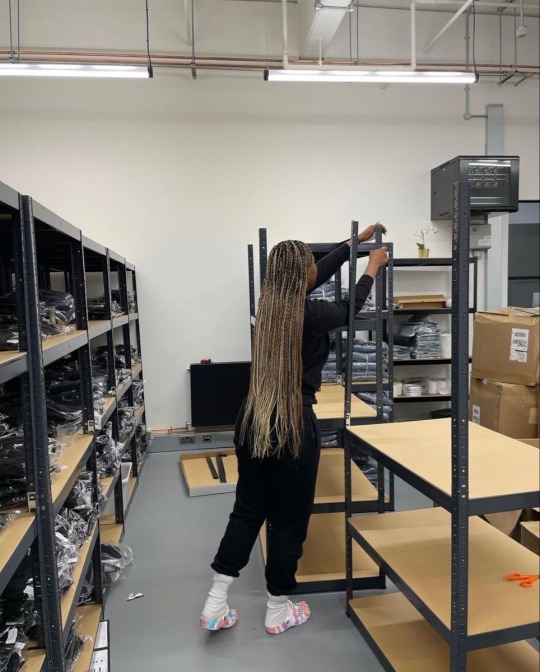



#level up#glow up#luxury#entrepreneur#spoiled heaux#blackgirlglowup#scaling business owner#confessions of a business owner
144 notes
·
View notes
Text
Switching to Firefox

This post is to answer @leaveblackkbrosalone’s question on my post about me switching to Firefox!
I recently had an eye opener moment when researching about Google and how they collect data to alter the things they recommend you and other things. And it was astonishing how much data they collect on you and how they track you every movement whilst on Google/Chrome/Other Google services e.g. Google PlayStore.
I truly believe there are better alternatives out there than the default Google Chrome people tend to use. We now live in world of constant data breaches and online tracking, therefore protecting your online privacy and security has never been more important.
I’ve recently deleted Chrome from my phone and computer and switched to FireFox and I’ll explain why~!

What is Firefox?


Firefox is the famous fox web browser! It is a free and open-source that is developed by the Mozilla Foundation. It's designed to be fast, secure, and customizable, and is available for multiple operating systems, including Windows, Mac, and Linux.
Firefox includes a suite of built-in features, such as enhanced tracking protection, custom themes (so important obviously) and add-ons, and a flexible interface that can be tailored to the user's needs.
Why Firefox and not Google Chrome?
There are a bunch of reasons why I chose to delete Google Chrome and why I prefer FireFox now, let me list some:
Privacy
Firefox has a strong focus on privacy and security, with features like built-in tracking protection and a strict anti-tracking policy.
In contrast, Chrome is owned by Google, a company that relies heavily on data collection and advertising for its business model.
Customisation
Firefox has a much more flexible and customizable interface than Chrome, with a wide range of add-ons (equivalent to Chrome’s ‘extensions’ I believe) and themes available to personalize your browsing experience.
Open-source
Firefox is an open-source project, meaning that anyone can contribute to its development and review the code for security issues.
Chrome, on the other hand, is based on the Chromium project, which is also open-source but is controlled by Google.
Cross-platform compatibility
Firefox works on a wide range of devices and operating systems, including Windows, Mac, Linux, and mobile devices.
Chrome is also available on multiple platforms, but it's more heavily integrated with Google's services and ecosystem.
Performance
Firefox has made significant improvements in recent years and is now a competitive browser in terms of speed and efficiency.
Still, Chrome is known for its fast performance
Community-driven
Firefox is developed by the non-profit Mozilla Foundation, which has a strong focus on user empowerment and community involvement. This means that Firefox users have a voice in the development process and can contribute to the browser's future direction.
With all of that being said, there is one particular area that caught my eye that I mentioned briefly: the Privacy and Security.
Firefox’s Privacy and Security Advantages
Firefox definitely has advantages in these areas than Google Chrome surprisingly!
Enhanced Tracking Protection
Firefox includes built-in tracking protection that blocks many common types of trackers by default, including
third-party cookies, cryptominers, and fingerprinters
This helps to protect your online privacy and reduce the amount of data that's collected about you. Below are the options for the 'Enhance Tracking Protection' in the settings:
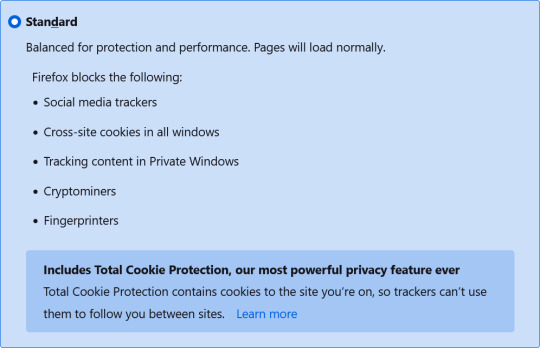
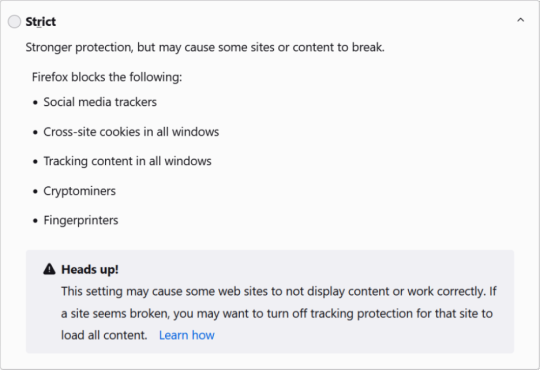
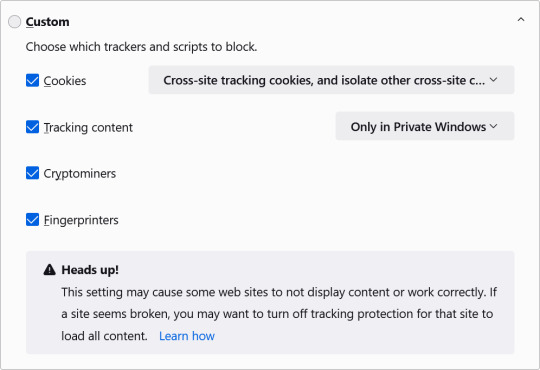
No Google Tracking
Oh boy, I like this one. So unlike Chrome, which is owned by Google and ties into its advertising and data collection ecosystem, Firefox is developed by the non-profit Mozilla Foundation and has no affiliation with Google or any other major tech company. This means that Firefox is less likely to collect and share your data with third parties.
No Sign-In Required
While Chrome requires you to sign in with a Google account to access certain features, Firefox does not require any sign-in at all. This means that you can still use Firefox without creating a user profile or linking your browsing activity to any personal information -
Don’t get me wrong, if you want to use the Google search engine WITHIN FireFox, it might still prompt you to sign in but you still don’t have to! Also, the choice is there to create an account just to sync bookmarks and tab from one device to another e.g. phone to laptop.
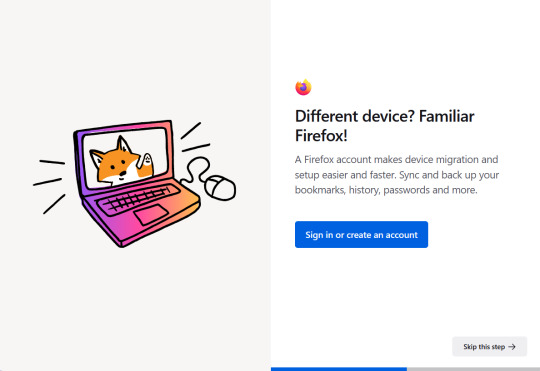
Private Browsing Mode
(Another very important part!) Firefox offers a Private Browsing mode that doesn't save your browsing history, cookies, or temporary files. This can be useful for browsing sensitive content or preventing others from seeing what you've been looking at.
Firefox's Private Browsing mode offers a more robust set of features for privacy and security than Google’s Incognito mode. Within the ‘Settings’, you can customise your privacy settings more extensively than Google Chrome. You can choose to block all third-party cookies, prevent websites from accessing your location data, and clear your browsing history and data automatically when you close the browser.
Google's Incognito mode does not block all cookies or prevent all forms of tracking.
Open-Source Security
Like I mentioned before, Firefox is an open-source project, meaning that anyone can review the code and contribute to its development. This helps to ensure that security vulnerabilities are identified and addressed quickly, and that the browser remains as secure as possible. You too can find something and report it to the repository via creating an issue!

To Conclude
Of course, these are just some general reasons why you might prefer Firefox over Chrome, and the choice ultimately comes down to personal preference and priorities. I know with developers, they would prefer Chrome for the dev tools and I think it’s almost a standard to use Chrome (though at my workplace we use Microsoft Edge), anyhoo Google is just a default for web browsing and search engine. I also know it’s hard if you have a whole Google ecosystem set up like Google docs to Sheet to Slides, emails, calendar etc, you can still use them but on a safer browser.
I would also recommend using ‘DuckDuckGo’ for a search engine as they too are really good with security and privacy but as a search engine (plus on their phone app they have a cool animation when you want to delete you browsing data from the tabs hehe)!
Links to interesting pages for more information on this topic:
YouTube videos: video 1 | video 2 | video 3 | video 4
Articles: article 1 | article 2 | article 3
I’d say give it a go, if you don’t like it I still recommend anything but Google Chrome! Well, that’s all and thank you for reading! 🥰👍🏾💗
#xc: programming blog post#programming#coding#studying#codeblr#progblr#studyblr#comp sci#computer science#firefox#google chrome#chrome#security and privacy#safer internet#security#privacy#data protection#user data
269 notes
·
View notes
Text

Discovering Tsukasa: A Quaint Hideaway in Yokohamabashi's Back Streets
Location: Yokohamabashi, Minami Ward, Yokohama, Japan
Timestamp: 18:40 on December 19, 2023
Fujifilm X100V with 5% diffusion filter
ISO 160 for 1.0 sec. at ƒ/6.4
Astia/Soft film simulation
Venturing into the dark, narrow alleys branching off from the brightly lit main drag of Yokohamabashi Shotengai shopping street, I discovered a quaint bar and eatery named “Tsukasa.”
The establishment, run by an elderly woman, served homemade dishes and drinks to customers engrossed in the sports news broadcast from a tiny TV perched atop a refrigerator in the corner behind the kitchen counter.
Inebriated salarymen in business suits and equally red-faced blue-collar workers, still in their factory uniforms, laughed loudly and became vocally excited about the baseball news emanating from the small screen.
This shop, absent from Google Maps with zero online reviews, barely seems to exist in the modern world. The only way to discover it is through word of mouth or by stumbling upon it while meandering through the back alleys branching off from Yokohamabashi Shotengai’s brightly lit main street.
As mentioned in previous posts, I appreciate the wide variety of noren curtains, particularly those with charming, traditional designs that hint at the owner's character, the establishment's vibe, and sometimes reveal a shop’s heritage.
I love the understated noren of this shop with its classic indigo blue called “ai” (藍) in Japanese. This indigo, made from the leaves of the Japanese indigo plant, was initially used by aristocrats and samurai. It can now be found adding color to everything from kimonos, blue jeans, linen, and of course, noren curtains.
The young bamboo plant motifs in the noren blend well with the real potted bamboo plant positioned just below it.
The storefront sign indicates “Sapporo” (the type of beer served at the shop) and, from top to bottom, right to left, reads “家庭料理・katei ryōri,” which means homemade cooking, and “つかさ・Tsukasa,” likely the owner’s name. Next time I visit, I hope to remember to ask about the origin of the name!
Explore other shops near Yokohamabashi Shotengai, and find references to related articles for further reading on my blog post: https://www.pix4japan.com/blog/20231219-yokohamabashi
#ストリートスナップ#つかさ#横浜#横浜橋商店街#昭和レトロ#pix4japan#X100V#Fujifilm#street photography#Japan#Yokohama#Yokohamabashi#Tsukasa
13 notes
·
View notes
Text
I said I would be posting more now that I have a laptop upstairs, and I will. I haven't posted much yet because I was still getting used to the keyboard and trying to get to a more comfortable typing speed that didn't frustrate me.
I actually bought a MacBook Air. I borrowed some money from my dad that I will be paying back over time. It's my first Apple product if you don't count the iPhone I got for my parents. It's a wonderful computer. The M1 chip is super zippy. Battery life is amazing. My former 12 year old laptop lasted about 2 hours per charge. This thing lasts me basically all day. The construction is very impressive. The aluminum body feels very sturdy. The screen is beautiful and gets way brighter than I need. And while they don't have any bass, I can't believe how good these tiny laptop speakers sound. My old laptop sounded like a super quiet AM radio. This thing hasn't gotten even mildly warm yet (though I am not rendering video or anything). It is very light. I feel comfortable taking it with me around the house if I need to. The old laptop was about 12 pounds and I think this is 2.75 or so.
Apple just makes good laptops. They always have, though they weren't always a great value. But I think the M1/M2 models are actually competitively priced as long as you don't get too many upgrades. The upgrade prices are still bonkers.
The OS has taken some getting used to. But for basic functions it's fine. I haven't had any trouble navigating. And the search function is much better than Windows. As is the aesthetics.
I don't really get into those technology pissing contests. I considered a Windows laptop, but there were just so many PC laptop choices and I was overwhelmed with the research required to find a good one. Not only can quality vary from manufacturer to manufacturer, but it can also vary from model to model. There are shitty Dells and fantastic Dells. I just didn't have the energy to figure out which was which. But I knew the new M1 Macs were all well reviewed and would serve my needs. So, that's what I got.
One bonus is that all of my friends are on iPhones and so now I can use iMessage and not turn into a dreaded green bubble. I still think Apple should make texting with android not crappy, but I'm happy to have a less frustrating way to communicate with my friends until that happens. If it ever does. (C'mon Europe, force Apple to fix that!)
Choosing tech these days is just about your needs and preferences. Brand loyalty is bullshit. All of the companies basically suck as far as business practices. Google might even be eviler these days. Microsoft has always been shit. And Dell has some of the worst customer service around. In this particular instance, Apple was the least evil choice for my needs and preferences. And anytime I need to do something only a PC can handle, I can just pop downstairs and use my desktop machine.
My only complaint so far is that I don't like how the scroll wheel functions with my bluetooth mouse. I like to scroll 3 lines at a time and Apple has this weird scroll acceleration feature that scrolls really slow at first and then crazy fast the more you scroll. I think there is a workaround but I haven't had the time to figure it out yet.
I'm excited to test out Photoshop, as I've heard the M1 version is about 50% faster. I just haven't had the energy to edit any photos recently.
So, that's my Apple experience so far. It's a good computer that I hope will last for many years. I also like that they maintain decent resale value if I need something different down the line.
100 notes
·
View notes
Text
Maximizing Your Taxi Business’s Online Presence: A Comprehensive SEO Guide

In today’s digital age, having a strong online presence is crucial for the success of any business, and taxi services are no exception. With the increasing reliance on the internet to find transportation options, it’s imperative for taxi companies to optimize their online visibility. Search Engine Optimization (SEO) is the key to achieving this goal. In this comprehensive guide, we’ll explore how taxi businesses can maximize their online presence through effective SEO strategies.
1. Keyword Research: The Foundation of SEO
Keyword research is the first and most crucial step in optimizing your taxi business’s online presence. Identify keywords and phrases potential customers are likely to use when searching for taxi services in your area. Tools like Google’s Keyword Planner can assist you in finding relevant keywords and assessing their search volume and competition.
For example, if your taxi company operates in New York City, relevant keywords might include “NYC taxi service,” “New York cab,” or “taxi near me.” Incorporate these keywords strategically throughout your website content, including your homepage, service pages, and blog posts.
2. Optimize Your Website for Mobile Users
In the age of smartphones, a mobile-responsive website is non-negotiable. Search engines like Google prioritize mobile-friendly websites in their rankings. A responsive design ensures that your site adapts to different screen sizes, providing a seamless experience for users on smartphones and tablets. This enhances user satisfaction and, subsequently, your search engine rankings.
3. Create Quality Content
High-quality, informative, and engaging content is the cornerstone of SEO success. Regularly publishing blog posts and articles related to taxi services, local events, and travel tips can attract visitors and keep them engaged. The longer visitors stay on your website, the better your SEO ranking. Content can also incorporate relevant keywords naturally, improving your visibility in search results.
4. Claim and Optimize Your Google My Business Listing
Google My Business (GMB) is a powerful tool for local SEO. Claim and optimize your GMB listing to ensure your taxi business appears in local search results and on Google Maps. Provide accurate information, including your business name, address, phone number, and hours of operation. Encourage customers to leave reviews, as positive reviews can boost your ranking.
5. Optimize Your Meta Tags
Meta tags, including meta titles and meta descriptions, play a significant role in SEO. Craft compelling meta titles that include your target keywords and meta descriptions that provide a brief but enticing overview of your services. These elements are what users see on search engine results pages, and they can significantly impact click-through rates.
6. Backlink Building
Backlinks, or links from other reputable websites to your own, are a strong signal to search engines that your site is authoritative and valuable. Reach out to local business directories, travel websites, and related industry publications to secure backlinks. Quality is more important than quantity, so focus on acquiring links from trusted sources.
7. Speed Up Your Website
A slow website can harm your SEO efforts. Visitors are more likely to leave if a page takes too long to load. Compress images, minimize code, and leverage content delivery networks (CDNs) to speed up your site. Tools like Google PageSpeed Insights can help you identify and rectify speed issues.
8. Monitor and Analyze Your Performance
Regularly monitoring your website’s performance is essential for success. Use tools like Google Analytics to track visitor behavior, source of traffic, and conversions. Adjust your SEO strategy based on the data, continually improving your online presence.
9. Utilize Social Media
While not a direct SEO factor, a strong social media presence can indirectly impact your online visibility. Share your blog posts and engage with your audience on platforms like Facebook, Twitter, and Instagram. Social media can help drive traffic to your website and boost your overall online presence.
10. Stay Informed and Adapt
The world of SEO is ever-evolving. Search engines frequently update their algorithms, and best practices change over time. To maintain a strong online presence, stay informed about the latest trends and adapt your SEO strategy accordingly.
In conclusion, a comprehensive SEO strategy is essential for maximizing your taxi business’s online presence. By conducting keyword research, optimizing your website for mobile, creating quality content, claiming your Google My Business listing, and implementing these other tips, you can enhance your visibility in local search results, attract more customers, and ultimately grow your taxi business. Remember that SEO is an ongoing process, so continuous efforts are key to long-term success in the digital age.
Source: https://kushitworld.com/2023/10/31/maximizing-your-taxi-businesss-online-presence-a-comprehensive-seo-guide/
#india#kushitworld#saharanpur#itcompany#seo#seoservices#webdevelopment#digitalmarketing#websitedesigning#digital marketing#TaxiSEOGuide#TaxiOnlinePresence#TaxiBusinessGrowth#TaxiMarketingStrategy#LocalTaxiSEO#TaxiWebsiteOptimization#TaxiSEOEssentials
9 notes
·
View notes
Text
New Business Marketing Tips and Tricks for Success
Starting a new business can be an exhilarating adventure, but it also comes with its fair share of challenges, especially in the competitive landscape of today's marketplace. To stand out and thrive, effective marketing is crucial. Here are four essential marketing tips and tricks to help your new business succeed:
Define Your Target Audience and Create Customer Personas:
One of the first steps in crafting a successful marketing strategy for your new business is to identify and understand your target audience. Who are your ideal customers, and what are their needs, preferences, and pain points? Creating customer personas can help you visualize and humanize your audience, making it easier to tailor your marketing efforts effectively.

Start by conducting market research to gather data about your potential customers. Analyze demographics, psychographics, and behavior patterns to create detailed customer personas. These personas should include information like age, gender, income, interests, and pain points.
Once you have a clear understanding of your target audience, customize your marketing messages and strategies to resonate with them. Craft compelling content, advertisements, and promotions that address their specific needs and desires. By speaking directly to your ideal customers, you'll increase the chances of building meaningful connections and driving conversions.
Leverage the Power of Digital Marketing:
In the digital age, online presence and digital marketing are indispensable for any new business. Here are some essential digital marketing strategies to consider:
a. Build a User-Friendly Website: Your website is often the first point of contact for potential customers. Ensure that it is well-designed, easy to navigate, and mobile-responsive. Optimize it for search engines (SEO) to improve your visibility in search results.
b. Content Marketing: Create valuable and relevant content that educates, entertains, or solves problems for your target audience. Blog posts, videos, infographics, and social media updates can all be part of your content marketing strategy.

c. Social Media Marketing: Identify the social media platforms where your audience is most active and engage with them there. Develop a content calendar and use a mix of organic and paid content to reach a wider audience.
d. Email Marketing: Build and nurture an email list to stay in touch with your customers. Send personalized and relevant content, offers, and updates to keep them engaged and informed.
e. Pay-Per-Click Advertising (PPC): Consider running targeted PPC campaigns on platforms like Google Ads and Facebook Ads to reach potential customers actively searching for your products or services.
Emphasize Customer Relationships and Engagement:
In a competitive market, building and maintaining strong customer relationships is vital. Consider these strategies to enhance customer engagement:
a. Provide Exceptional Customer Service: Respond promptly to inquiries and address customer concerns with care. Happy customers are more likely to become loyal advocates for your brand.
b. Personalization: Use customer data and segmentation to personalize your marketing messages and offers. People appreciate tailored experiences that cater to their unique preferences.

c. Encourage User-Generated Content: Encourage customers to share their experiences with your products or services on social media or review platforms. User-generated content can build trust and credibility.
d. Loyalty Programs: Reward repeat customers with loyalty programs, discounts, or exclusive access to new products or services. Loyalty programs can foster long-term relationships and increase customer retention.
Monitor, Analyze, and Adapt:
Marketing is not a one-size-fits-all endeavor. To continually improve your strategies, track key performance indicators (KPIs) and adapt based on the data:
a. Use Analytics Tools: Employ tools like Google Analytics, social media insights, and email marketing metrics to monitor the performance of your marketing efforts.
b. A/B Testing: Experiment with different marketing approaches and compare their results through A/B testing. This allows you to refine your strategies over time.

c. Stay Informed: Keep up with industry trends, competitors, and evolving customer preferences. Stay open to adjusting your marketing plan as needed.
In conclusion, successful marketing for a new business involves understanding your audience, utilizing digital strategies, fostering customer relationships, and staying adaptable. By implementing these tips and tricks, your new business can navigate the competitive landscape and carve out its own path to success.
#seo#online marketing#digitalmarketing#marketing agency#learn digital marketing#digital marketing service#seo marketing#digital marketing course#digital marketing#seo expert#business success#business marketing#marketing tips
19 notes
·
View notes
Text
Navigating the Digital Frontier: Choosing the Right Web Development Company in India
In the rapidly evolving digital landscape, having a strong online presence is no longer optional—it's essential. Whether you're a budding startup or an established enterprise, the foundation of your online success hinges on the quality of your website. This is where choosing the best web development company in India becomes crucial.
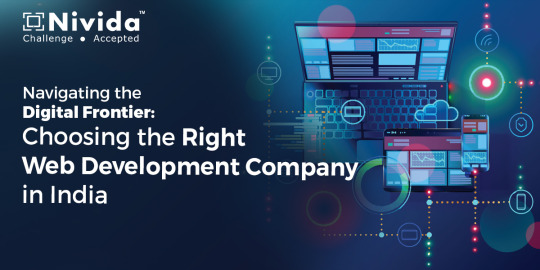
Why India?
India has emerged as a global hub for technology and innovation, boasting a pool of highly skilled developers and cutting-edge technology solutions. Companies worldwide are turning to India for their web development needs due to its cost-effective services, timely delivery, and exceptional quality.
What to Look for in the Best Web Development Company in India
Selecting the right web development partner is a critical decision that can shape the future of your business. Here are some key factors to consider:
1. Expertise and Experience
Experience is a testament to a company's ability to deliver quality services. Look for a web development company with a robust portfolio that showcases their expertise across various industries. A company that has successfully executed diverse projects is more likely to understand and meet your unique requirements.
2. Custom Solutions
The best web development company in India will offer customized solutions tailored to your business needs. Avoid firms that rely on one-size-fits-all templates. Your website should reflect your brand's identity and cater to your target audience.
3. Technology Stack
Ensure the company is proficient in the latest technologies and development frameworks. Whether it's HTML5, CSS3, JavaScript, or advanced frameworks like React, Angular, and Vue.js, the right technology stack can significantly enhance your website's performance and user experience.
4. Client Reviews and Testimonials
Reputation matters. Check client reviews and testimonials to gauge the company's reliability and service quality. Platforms like Clutch, Upwork, and Google Reviews can provide valuable insights into the experiences of past clients.
5. Post-Launch Support
A reliable web development company doesn't just deliver the project and disappear. Look for firms that offer robust post-launch support and maintenance services to ensure your website remains up-to-date and functional.
Spotlight on Gujarat: The Best Web Development Company in Gujarat
While India, as a whole, is a powerhouse of web development talent, certain regions stand out for their exceptional contributions. Gujarat is one such region, known for its thriving IT industry and innovation-driven approach.
Why Choose a Web Development Company in Gujarat?
Skilled Workforce: Gujarat boasts a large pool of highly skilled developers who are adept at the latest technologies.
Cost-Effective Services: Companies in Gujarat offer competitive pricing without compromising on quality, making it an attractive option for businesses globally.
Robust Infrastructure: With state-of-the-art infrastructure and a conducive business environment, Gujarat is home to some of the best web development companies in India.
Conclusion
Navigating the digital frontier requires a reliable and skilled partner. Whether you're looking for the best web development company in India or the best web development company in Gujarat, the key lies in thorough research and due diligence. By focusing on expertise, customization, technology proficiency, client feedback, and post-launch support, you can ensure that your web development journey is smooth and successful.
Investing in the right web development company is not just about building a website; it's about creating a digital presence that drives growth, engages users, and stands out in a competitive market. Make your choice wisely and watch your business thrive in the digital age.
3 notes
·
View notes
Text
What is Digital marketing and how can we earn from it?
According to me I can offer valuable insights into the field and lucrative earning opportunities. Digital marketing involves promoting products, services, or brands through various online channels, including websites, social media, search engines, email, and mobile apps. Here are some strategies and examples that are working well for freelancers in the digital marketing industry:
Content Creation and Marketing: Content remains king in digital marketing, and freelancers can capitalize on this by offering content creation services such as blog writing, article writing, video production, and infographic design. High-quality, engaging content helps businesses attract and retain customers while improving their search engine rankings.
Example: A freelance writer specializing in technology creates informative blog posts and whitepapers for software companies, helping them establish thought leadership in their industry and drive organic traffic to their website.
Search Engine Optimization (SEO): SEO is essential for businesses to improve their visibility in search engine results pages (SERPs) and drive organic traffic to their websites. Freelancers can offer SEO services such as keyword research, on-page optimization, link building, and SEO audits to help clients rank higher in search engine rankings.
Example: An SEO specialist helps a local bakery optimize its website for relevant keywords such as "best cakes in [city]," resulting in increased online visibility and more foot traffic to the bakery.
Social Media Management: Many businesses struggle to effectively manage their social media presence. Freelancers can offer social media management services, including content creation, posting schedules, community engagement, and paid advertising campaigns, to help clients grow their social media following and drive engagement.
Example: A freelance social media manager helps a small business owner create and curate engaging content for their Instagram account, increasing brand awareness and attracting new customers.
Email Marketing: Email marketing remains one of the most effective ways to nurture leads, promote products or services, and maintain customer relationships. Freelancers can offer email marketing services such as email campaign creation, list segmentation, A/B testing, and performance tracking to help clients generate leads and drive sales.
Example: An email marketing freelancer designs and implements a series of automated email campaigns for an e-commerce retailer, resulting in higher open rates, click-through rates, and conversions.
Pay-Per-Click (PPC) Advertising: PPC advertising allows businesses to reach their target audience through targeted ads on search engines and social media platforms. Freelancers can offer PPC management services, including keyword research, ad creation, bid management, and performance tracking, to help clients maximize their return on investment (ROI) from PPC campaigns.
Example: A freelance PPC specialist helps a startup company launch and optimize Google Ads campaigns, driving qualified traffic to their website and increasing sales leads.
Affiliate Marketing: Freelancers can participate in affiliate marketing programs to earn commissions by promoting products or services through their website, blog, or social media channels. By partnering with companies as affiliates, freelancers can monetize their online presence and audience.
Example: A freelance blogger writes product reviews and tutorials on their website and includes affiliate links to recommended products, earning commissions for every sale generated through their affiliate links.
Ready to take your digital marketing skills to the next level? Enroll now in our comprehensive free online masterclass and unlock the secrets to success in the ever-evolving world of digital marketing.
#digital marketing#masterclass#learn#online earning#affliate#freelance#career#career in digital marketing
2 notes
·
View notes
Text
Maximizing ROI: How E-commerce Businesses Can Harness the Power of SEO
In the highly competitive world of e-commerce, driving traffic to your online store and maximizing return on investment (ROI) are paramount for success. While paid advertising and social media marketing can certainly play a role, search engine optimization (SEO) remains a powerful and cost-effective strategy for e-commerce businesses to attract organic traffic, improve visibility, and increase sales. In this blog post, we'll explore how e-commerce businesses can harness the power of SEO to maximize their ROI and achieve sustainable growth.
Understanding the Importance of SEO for E-commerce
SEO is the process of optimizing your website to rank higher in search engine results pages (SERPs) for relevant keywords and phrases. For e-commerce businesses, a strong SEO strategy is essential for increasing visibility, driving targeted traffic, and ultimately boosting sales. With millions of online stores competing for attention, appearing at the top of search results can make a significant difference in attracting customers and generating revenue.
Key Strategies for E-commerce SEO Optimization
Keyword Research and Optimization: Start by conducting keyword research to identify the terms and phrases that potential customers are using to search for products in your niche. Focus on long-tail keywords with high search volume and low competition, and incorporate them strategically into your product titles, descriptions, and meta tags to improve your visibility in search results.
Optimize Product Pages: Each product page on your e-commerce website presents an opportunity to attract organic traffic and convert visitors into customers. Optimize your product pages by including descriptive and keyword-rich titles, engaging product descriptions, high-quality images, and customer reviews. Use structured data markup to provide search engines with additional information about your products, such as price, availability, and ratings.
Improve Site Speed and Mobile Responsiveness: Page speed and mobile responsiveness are crucial ranking factors in Google's algorithm, especially for e-commerce websites. Optimize your website's performance by minimizing page load times, optimizing images and code, and ensuring that your site is mobile-friendly and responsive across all devices and screen sizes. A fast and mobile-friendly website not only improves user experience but also boosts your chances of ranking higher in search results.
Create High-Quality Content: In addition to product pages, creating high-quality content can help attract organic traffic and build authority for your e-commerce website. Consider adding a blog section or resources page where you can publish informative articles, how-to guides, and product reviews related to your industry or niche. By providing valuable content that addresses your target audience's needs and interests, you can attract more visitors to your site and improve your SEO performance.
Optimize for Local SEO (if applicable): If your e-commerce business has a physical storefront or serves a specific geographic area, optimizing for local SEO can help you attract local customers and drive foot traffic to your store. Claim and optimize your Google My Business listing, include local keywords in your content and meta tags, and encourage satisfied customers to leave positive reviews. Additionally, consider participating in local events or sponsoring community initiatives to increase your visibility and credibility in the local market.
Conclusion
SEO remains a powerful tool for e-commerce businesses looking to maximize their ROI and achieve long-term success in the competitive online marketplace. By implementing the strategies outlined in this blog post, you can improve your website's visibility, attract more organic traffic, and ultimately increase sales and revenue for your e-commerce business. Remember to stay updated on the latest SEO trends and best practices, continuously monitor your website's performance, and adapt your strategy as needed to stay ahead of the competition and maximize your ROI.
3 notes
·
View notes
Text
Unveiling the Power of Local SEO: How an SEO Agency Near Me Can Identify and Leverage Local Trends for Your Business

In the ever-evolving landscape of digital marketing, staying ahead of the curve is crucial for the success of any business. One of the most effective strategies to achieve this is by harnessing the power of local search engine optimization (SEO). For businesses looking to enhance their online visibility and connect with local customers, partnering with an SEO agency near me is not just a choice but a strategic move towards growth.
Local SEO: A Brief Overview
Local SEO is a specialized branch of search engine optimization that focuses on optimizing a business's online presence to attract local customers. With the majority of consumers relying on search engines to find products and services in their vicinity, local SEO becomes a game-changer for businesses aiming to thrive in their local markets.
The Role of an SEO Agency Near Me
Collaborating with an SEO agency near me offers several advantages, particularly in understanding and leveraging local trends. Here's how such an agency can identify and capitalize on these trends to propel your business forward:
Proximity to Local Dynamics
An SEO agency near you inherently understands the local dynamics, culture, and trends that shape your business environment. This proximity enables them to create targeted strategies that resonate with your local audience, ensuring that your business is aligned with the specific needs and preferences of your community.
Keyword Optimization for Local Searches
Localized keywords play a pivotal role in enhancing your business's visibility in local search results. An SEO agency near me possesses the knowledge to identify and leverage the most relevant local keywords for your business. This includes incorporating location-specific terms that potential customers are likely to use when searching for products or services in your area.
Google My Business Optimization
For businesses aiming to thrive locally, optimizing their Google My Business (GMB) listing is paramount. An SEO agency near me can ensure that your GMB profile is not only complete and accurate but also optimized for local searches. This includes managing customer reviews, updating business information, and utilizing GMB features to engage with your local audience effectively.
Content Localization Strategies
Local trends are often reflected in the way people consume content. An SEO agency near you can tailor your content to align with the interests and preferences of your local audience. Whether it's creating blog posts, social media updates, or other content types, a local SEO expert can craft materials that resonate with your community, fostering a stronger connection with potential customers.
Mobile Optimization for Local Searches
As mobile devices become increasingly integral to the way people search for local businesses, optimizing your website for mobile is crucial. An SEO agency near me can ensure that your website is not only mobile-friendly but also optimized for local searches, providing a seamless experience for users searching for products or services on the go.
Hyperlocal Targeting
Understanding the nuances of different neighborhoods within your local area is vital for effective hyperlocal targeting. An SEO agency near you can delve deep into the specifics of your community, identifying trends and preferences that may vary from one neighborhood to another. This insight allows for the creation of hyper-targeted campaigns that resonate with specific local demographics.
Community Engagement Strategies
Local trends are often shaped by community events, activities, and discussions. An SEO agency near me can develop strategies that involve active participation in local community engagement, whether through partnerships, sponsorships, or online forums. By becoming an integral part of the local community, your business can enhance its reputation and visibility.
Conclusion
In the dynamic world of digital marketing, leveraging local SEO trends is indispensable for businesses seeking to establish a strong online presence within their communities. Collaborating with an SEO agency near you is a strategic decision that goes beyond mere geographical proximity. It opens the door to a wealth of localized insights, ensuring that your business is well-positioned to capitalize on the unique trends and opportunities in your area. Embrace the power of local SEO, and let an SEO agency near me guide your business towards sustained growth in the ever-evolving digital landscape.
#seo#digitalmarketing#marketing#socialmediamarketing#socialmedia#webdesign#branding#business#onlinemarketing#contentmarketing#website#marketingdigital#searchengineoptimization#surajmahawar#ecommerce#webdevelopment#digitalmarketingagency#marketingstrategy#instagram#advertising#entrepreneur#marketingtips#design#wordpress#digital#graphicdesign#websitedesign#smallbusiness#smm#emailmarketing
3 notes
·
View notes
Text
Boost Your SEO: High-Quality Backlinking Sites ( Google Drive Link )
In the competitive world of SEO, backlinks reign supreme. They act as votes of confidence from other websites, telling search engines like Google that your content is valuable and deserves to be seen. But building a strong backlink profile can be expensive, leaving many websites struggling to compete. Fear not, budget-conscious SEO warriors! This article unveils a treasure trove of high-quality backlinking sites that won't cost you a dime.
2024's Guide to High-Quality Dofollow Backlink Sites
Top Free Backlink Building Sites in 2024
Top Profile Creation Site List for Backlinks in 2024
Top Instant Approval Blog Commenting Sites List (2024)
Top Free Guest Posting Websites in 2024
Disclaimer: While these sites offer free backlinks, remember, quality matters more than quantity. Focus on building relevant, contextual links from websites with good domain authority. Spammy tactics can actually harm your SEO, so proceed with caution and prioritize quality over sheer number.
Unleash the Power of Directories:
Industry-Specific Directories: List your website in relevant online directories within your niche. These directories often offer free basic listings, providing a valuable backlink and increased visibility within your target audience.
Local Directories: Claim and optimize your Google My Business listing, along with other local directories like Yelp and Bing Places. Local SEO is crucial, and these platforms offer free listings to boost your local search ranking.
Content is King (and Can Earn You Backlinks):
Guest Blogging: Contribute high-quality articles to established blogs in your niche. This not only builds backlinks but also positions you as an expert and drives targeted traffic to your website.
Forum Engagement: Actively participate in relevant online forums and communities. Share valuable insights, answer questions, and link back to your website where appropriate. Remember, genuine engagement is key, not just spamming links.
Get Creative with Social Media:
Share Engaging Content: Regularly share informative, visually appealing content on social media platforms. Encourage users to share and link back to your website, organically building backlinks.
Run Social Media Contests: Host contests and giveaways that require participants to share your content or link back to your website. This can be a fun and effective way to generate buzz and backlinks.
Embrace the Power of User-Generated Content:
Encourage Reviews and Testimonials: Display positive reviews and testimonials on your website, and encourage satisfied customers to share them on other platforms. This can lead to organic backlinks from review sites and social media.
Run User-Generated Content Contests: Encourage users to create content related to your brand or niche, offering rewards for the best submissions. This can generate backlinks from user profiles and social media shares.
Remember: Building a strong backlink profile takes time and effort. Utilize these free resources strategically, focusing on quality and relevance. With patience, persistence, and a dash of creativity, you can achieve SEO success without breaking the bank!
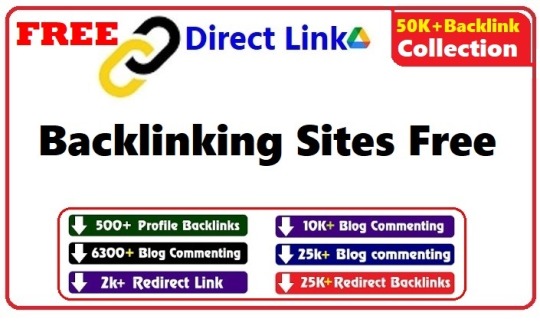
Bonus Tip: Utilize free backlink analysis tools like Ahrefs Backlink Checker or Moz Open Site Explorer to monitor your backlink profile and identify potential opportunities.
Disclaimer: I am not affiliated with any of the websites mentioned in this article. Please do your own research before submitting your website to any directory or platform.
3 notes
·
View notes